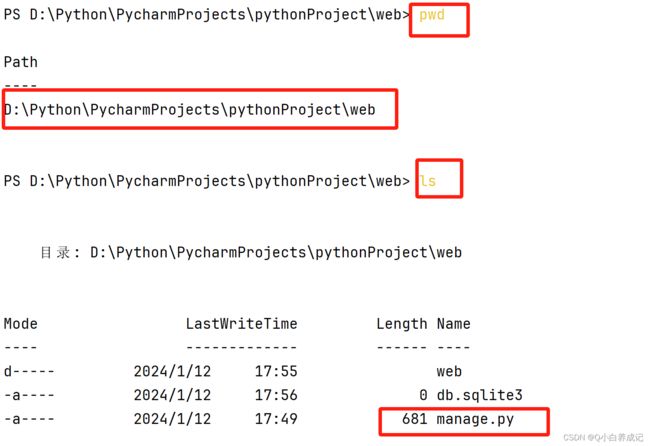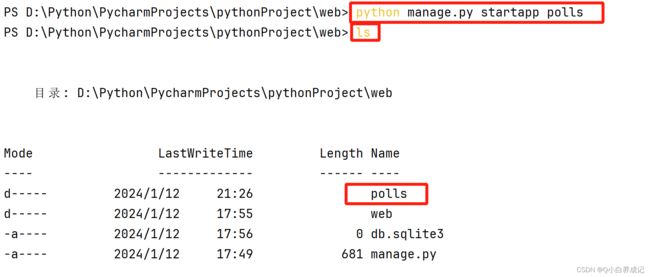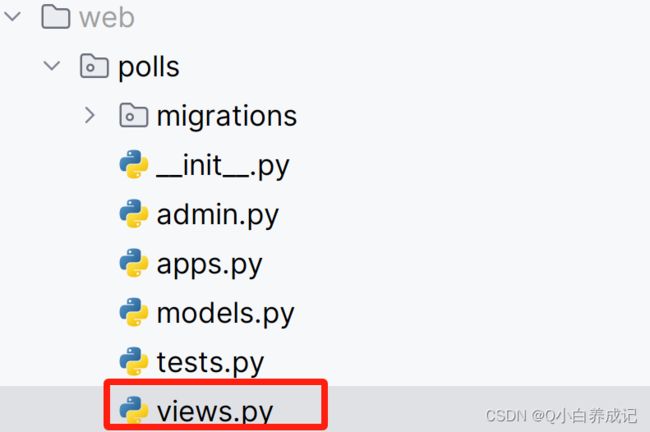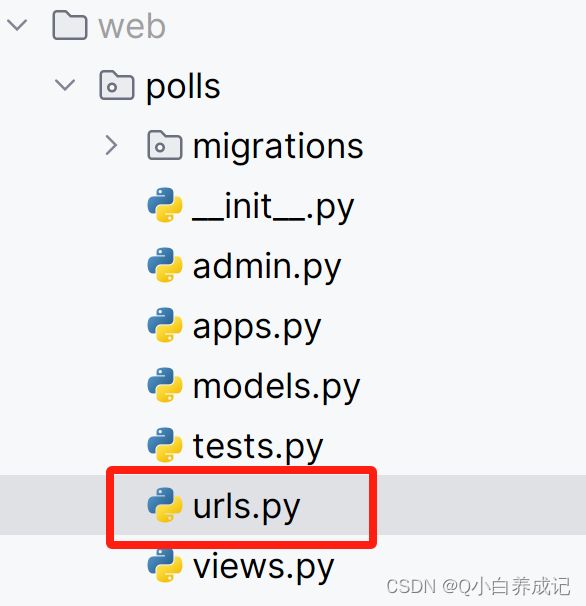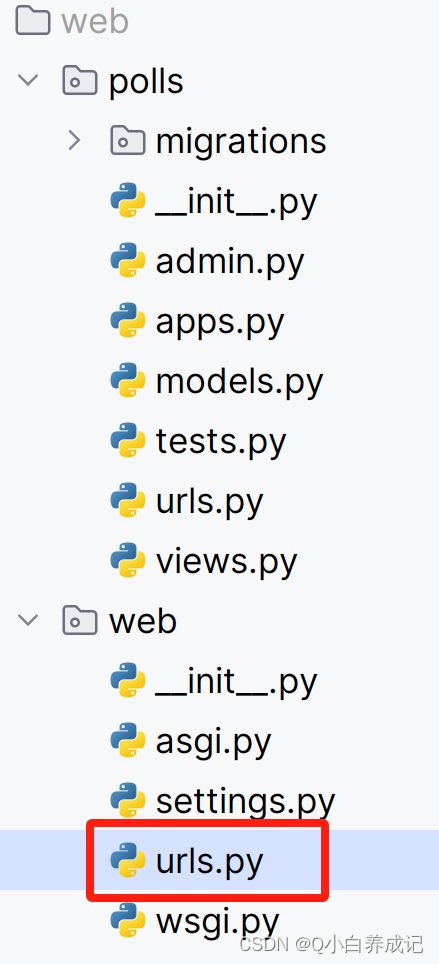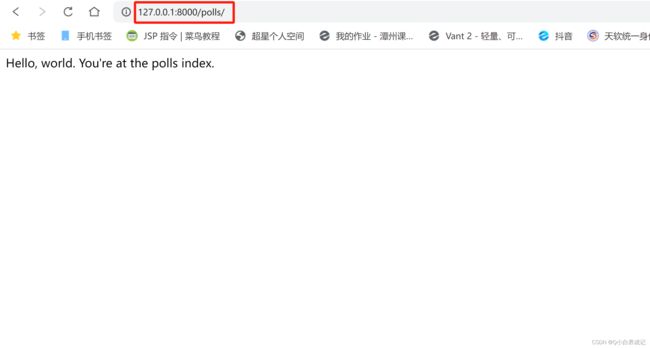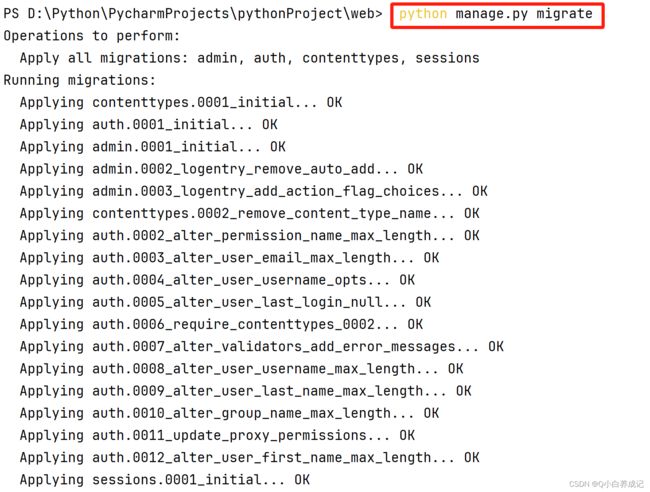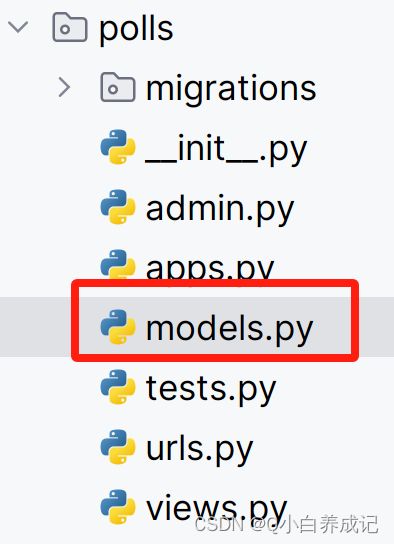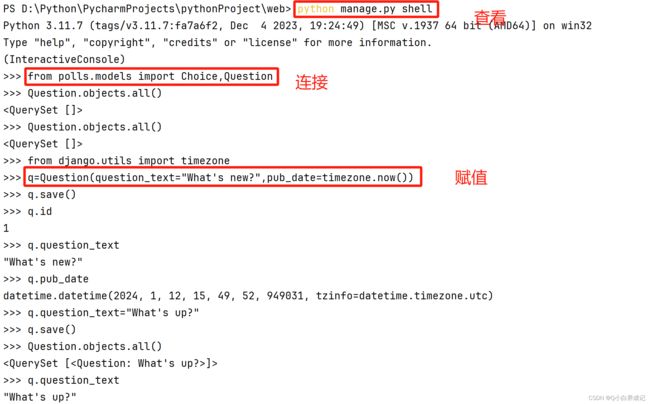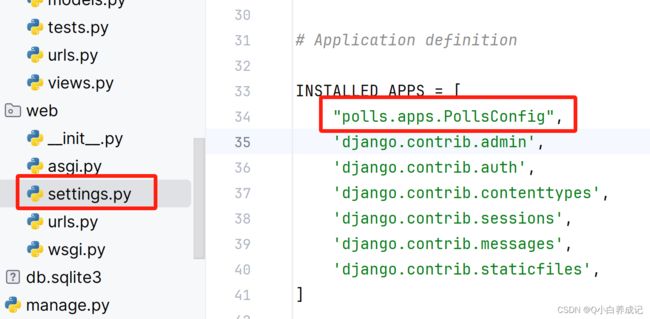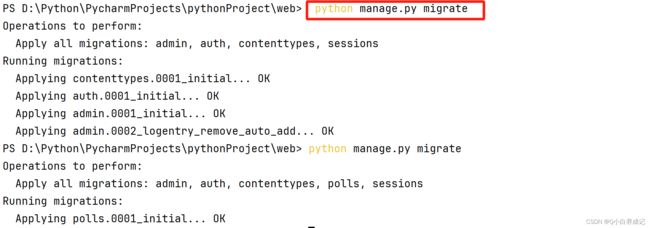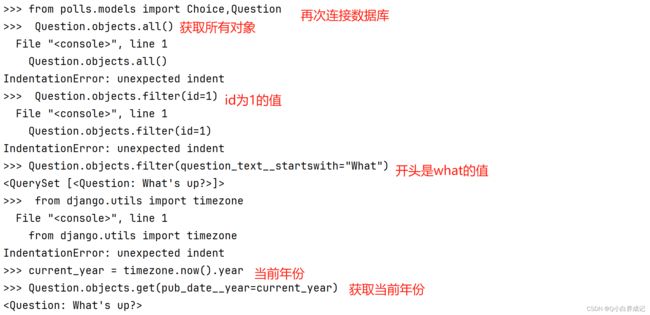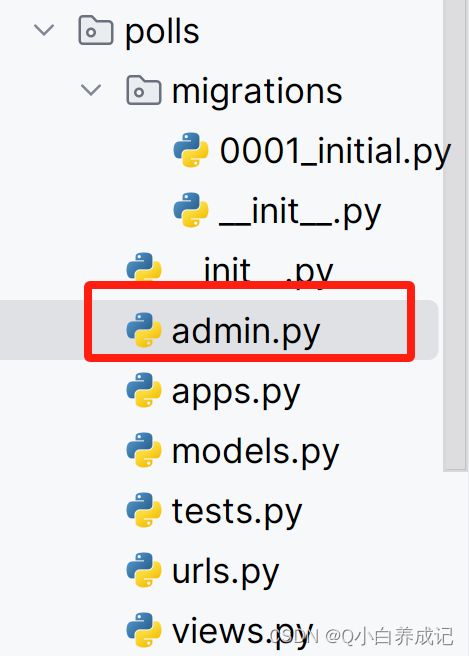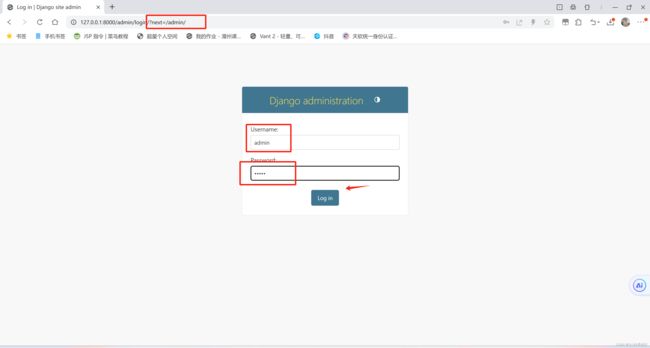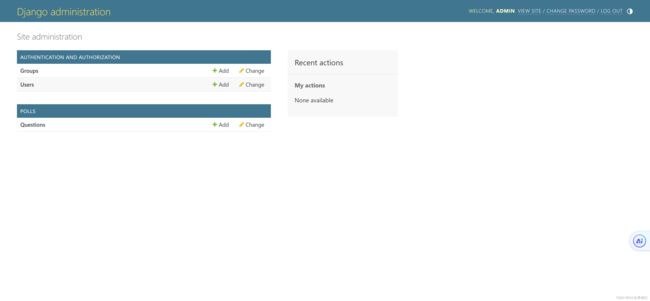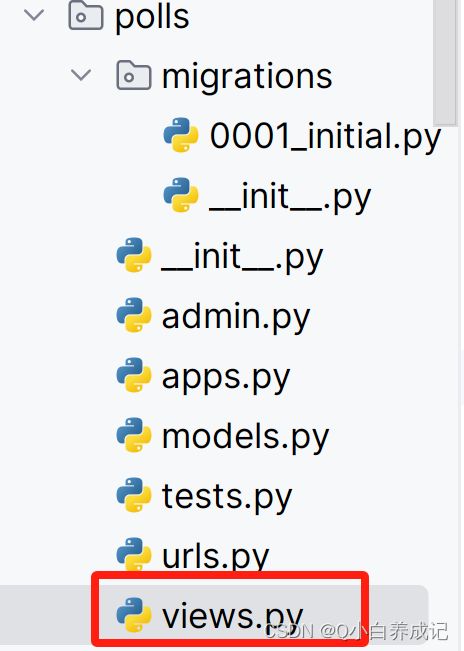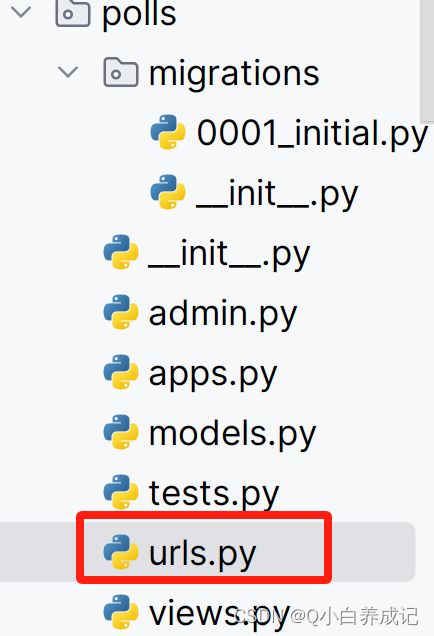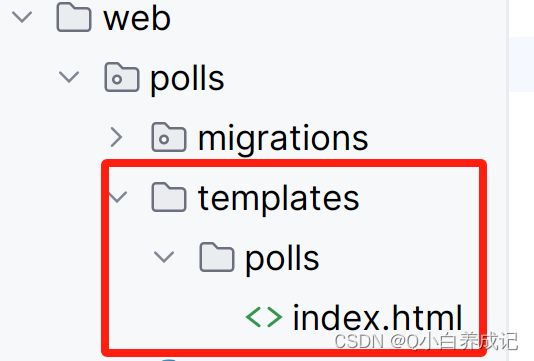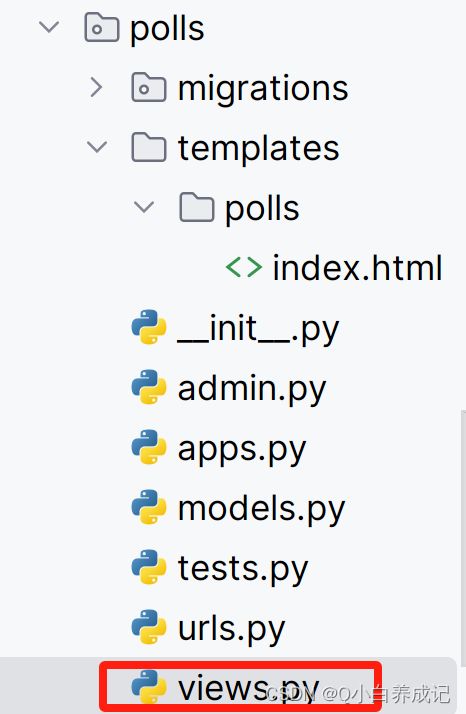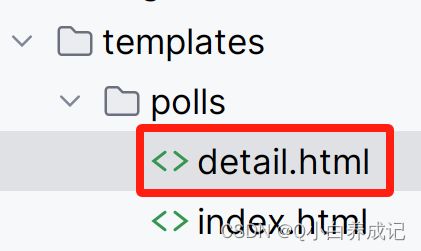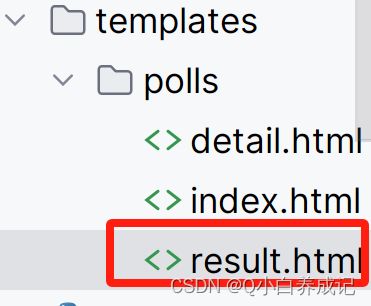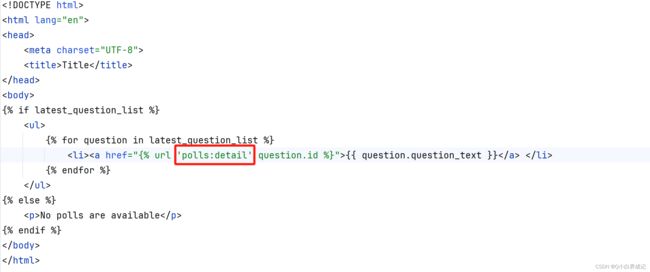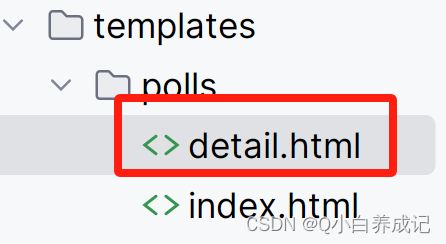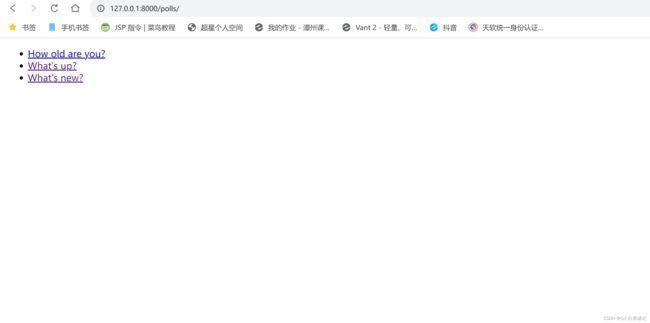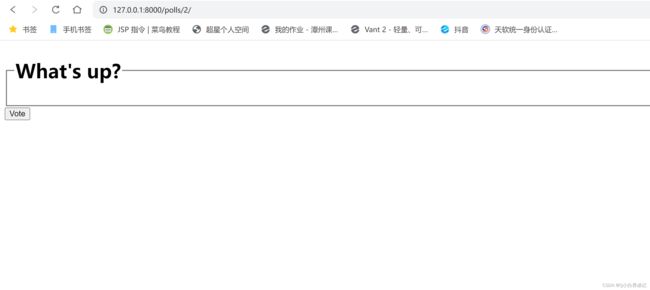基于Django的python小应用——投票
一、首先需要创建应用的环境
将在manage.py 同级目录下创建投票应用。
这样它就可以作为顶级模块导入,而不是 mysite 的子模块。
首先确定自己现在处于 manage.py 所在的目录下
确定路径:
初始化应用:
python manage.py startapp polls
二、编写第一个视图
polls/views.py
from django.shortcuts import render
from django.http import HttpResponse
# Create your views here.
def index(request):
return HttpResponse("Hello, world. You're at the polls index.")
想要查看上面的视图,就需要将一个 URL 映射到它,下面将一个url映射到应用内
polls/urls.py
from django.urls import path
from . import views
urlpatterns = [
path("", views.index, name="index"),
]
想要查看上面的视图,就需要将一个 URL 映射到它,下面将应用增加到项目的url配置中
web/urls.py
from django.contrib import admin
from django.urls import include,path
from web import *
urlpatterns = [
path("polls/", include('polls.urls')),
path('admin/', admin.site.urls),
]
运行应用,进入网址,在网址后面输入我们要进入的页面/polls,然后回车
函数 include() 允许引用其它 URLconfs。每当 Django 遇到 include() 时,它会截断与此项匹配的 URL 的部分,并将剩余的字符串发送到 URLconf 以供进一步处理。
include() 的理念是使其可以即插即用。因为投票应用有它自己的 URLconf( polls/urls.py ),他们能够被放在 "/polls/" , "/fun_polls/" ,"/content/polls/",或者其他任何路径下,这个应用都能够正常工作。
三、设计一个应用的数据库
创建数据表
执行下面的操作
python manage.py migrate
创建模型
polls/models.py
from django.db import models
# Create your models here.
class Question(models.Model):
question_text = models.CharField(max_length=200)
pub_date = models.DateTimeField("date published")
class Choice(models.Model):
question = models.ForeignKey(Question, on_delete=models.CASCADE)
choice_text = models.CharField(max_length=200)
votes = models.IntegerField(default=0)
激活模型
上面的一小段用于创建模型的代码给了 Django 很多信息,通过这些信息,Django 可以:
为这个应用创建数据库 schema(生成 CREATE TABLE 语句)。
创建可以与 Question 和 Choice 对象进行交互的 Python 数据库 API。
但是首先得把 polls 应用安装到项目里。
为了在我们的工程中包含这个应用,我们需要在配置类 INSTALLED_APPS 中添加设置。
因为 PollsConfig 类写在文件 polls/apps.py 中,所以它的点式路径是 'polls.apps.PollsConfig'。
在文件 web/settings.py 中 INSTALLED_APPS 子项添加点式路径。
"polls.apps.PollsConfig",运行迁移命令,生成数据迁移文件
python manage.py makemigrations polls创建新定义的模型的数据表
真正让数据变化生效的命令是migate。
运行 migrate 命令,在数据库里创建新定义的模型的数据表:
python manage.py migrate
改变模型需要这三步:
编辑 models.py 文件,改变模型。
运行 python manage.py makemigrations 为模型的改变生成迁移文件。
运行 python manage.py migrate 来应用数据库迁移。
查看数据库的数据
python manage.py shell修改一下模型,来让调试具有更高的可读性
import datetime
from django.db import models
# Create your models here.
class Question(models.Model):
question_text = models.CharField(max_length=200)
pub_date = models.DateTimeField("date published")
#新增
def __str__(self):
return self.question_text
def was_published_recently(self):
now = timezone.now()
return now - datetime.timedelta(days=1) <= self.pub_date <= now
class Choice(models.Model):
question = models.ForeignKey(Question, on_delete=models.CASCADE)
choice_text = models.CharField(max_length=200)
votes = models.IntegerField(default=0)
#新增
def __str__(self):
return self.choice_text连接管理站
创建管理员账号
python manage.py createsuperuser
启动开发服务器
python manage.py runserver
在管理页面中添加投票应用,修改文件polls/admin.py
from django.contrib import admin
from .models import Question
admin.site.register(Question)
在网址输入/admin进入管理站,输入你的用户名和密码
现在可以直接从管理站添加新的投票和选项了
四、创建更多的视图
在我们的投票应用中,我们需要下列几个视图:
- 问题索引页——展示最近的几个投票问题。
- 问题详情页——展示某个投票的问题和不带结果的选项列表。
- 问题结果页——展示某个投票的结果。
- 投票处理器——用于响应用户为某个问题的特定选项投票的操作。
向 polls/views.py 里添加更多视图
from django.shortcuts import render
from django.http import HttpResponse
# Create your views here.
def index(request):
return HttpResponse("Hello, world. You're at the polls index.")
# 新增
def detail(request, question_id):
return HttpResponse("You're looking at question %s." % question_id)
def results(request, question_id):
response = "You're looking at the results of question %s."
return HttpResponse(response % question_id)
def vote(request, question_id):
return HttpResponse("You're voting on question %s." % question_id)
把这些新视图添加进 polls/urls.py 模块里
from django.urls import path
from . import views
urlpatterns = [
# ex: /polls/
path("", views.index, name="index"),
# ex: /polls/5/
path("/", views.detail, name="detail"),
# ex: /polls/5/results/
path("/results/", views.results, name="results"),
# ex: /polls/5/vote/
path("/vote/", views.vote, name="vote"),
]
每个视图必须要做的只有两件事:返回一个被请求页面内容的HttpResponse对象,或者抛出一个异常。
修改polls/views.py
from django.shortcuts import render
from django.http import HttpResponse
from .models import Question
# Create your views here.
def index(request):
latest_question_list = Question.objects.order_by("-pub_date")[:5]
output = ", ".join([q.question_text for q in latest_question_list])
return HttpResponse(output)
# 新增
def detail(request, question_id):
return HttpResponse("You're looking at question %s." % question_id)
def results(request, question_id):
response = "You're looking at the results of question %s."
return HttpResponse(response % question_id)
def vote(request, question_id):
return HttpResponse("You're voting on question %s." % question_id)
页面的设计写死在视图函数的代码里的。
所以让我们使用 Django 的模板系统,只要创建一个视图,就可以将页面的设计从代码中分离出来。
在polls 目录里创建一个 templates 目录
Django 将会在这个目录里查找模板文件。
在创建的 templates 目录里,再创建一个目录 polls,然后在其中新建一个文件 index.html 。模板文件的路径应该是 polls/templates/polls/index.html 。
更新一下 polls/views.py 里的 index 视图来使用模板:
from django.shortcuts import render
from django.http import HttpResponse
from django.template import loader
from .models import Question
# Create your views here.
def index(request):
latest_question_list = Question.objects.order_by("-pub_date")[:5]
template = loader.get_template("polls\index.html")
context = {
"latest_question_list": latest_question_list,
}
return HttpResponse(template.render(context, request))
# 新增
def detail(request, question_id):
return HttpResponse("You're looking at question %s." % question_id)
def results(request, question_id):
response = "You're looking at the results of question %s."
return HttpResponse(response % question_id)
def vote(request, question_id):
return HttpResponse("You're voting on question %s." % question_id)
尝试用 get() 函数获取一个对象,如果不存在就抛出 Http404 错误也是一个普遍的流程。
from django.shortcuts import render
from django.http import HttpResponse
from django.http import Http404
from django.shortcuts import get_object_or_404, render
from django.template import loader
from .models import Question
# Create your views here.
def index(request):
latest_question_list = Question.objects.order_by("-pub_date")[:5]
template = loader.get_template("polls\index.html")
context = {
"latest_question_list": latest_question_list,
}
return HttpResponse(template.render(context, request))
# 新增
def detail(request, question_id):
def detail(request, question_id):
question = get_object_or_404(Question, pk=question_id)
return render(request, "polls/detail.html", {"question": question})
def results(request, question_id):
response = "You're looking at the results of question %s."
return HttpResponse(response % question_id)
def vote(request, question_id):
return HttpResponse("You're voting on question %s." % question_id)
设计detail视图对应的模板
polls/templates/polls/detail.html
Title
{{ question.question_text }}
{% for choice in question.choice_set.all %}
- {{ choice.choice_text }}
{% endfor %}
创建一个 polls/results.html 模板:
polls/templates/polls/results.html
My test page
{{ question.question_text }}
{% for choice in question.choice_set.all %}
- {{ choice.choice_text }} -- {{ choice.votes }} vote{{ choice.votes|pluralize }}
{% endfor %}
Vote again?
去除index中的硬编码
Title
{% if latest_question_list %}
{% for question in latest_question_list %}
- {{ question.question_text }}
{% endfor %}
{% else %}
No polls are available
{% endif %}
为url添加命名空间,以面对错综复杂的应用路径。
polls/urls.py
from django.urls import path
from . import views
app_name = "polls"
urlpatterns = [
# ex: /polls/
path("", views.index, name="index"),
# ex: /polls/5/
path("/", views.detail, name="detail"),
# ex: /polls/5/results/
path("/results/", views.results, name="results"),
# ex: /polls/5/vote/
path("/vote/", views.vote, name="vote"),
]
再次调整index.html中编码,以命名空间来调用
五、使用表单
更新一下投票详细页面的模板
polls/detail.html
Title
将下面的代码添加到
polls/views.py
from django.http import HttpResponse, HttpResponseRedirect
from django.urls import reverse
def vote(request, question_id):
question = get_object_or_404(Question, pk=question_id)
try:
selected_choice = question.choice_set.get(pk=request.POST["choice"])
except (KeyError, Choice.DoesNotExist):
# Redisplay the question voting form.
return render(
request,
"polls/detail.html",
{
"question": question,
"error_message": "You didn't select a choice.",
},
)
else:
selected_choice.votes += 1
selected_choice.save()
return HttpResponseRedirect(reverse("polls:results", args=(question.id,)))
将投票应用转换成使用通用视图系统,这样可以删除许多代码。
仅仅需要做以下几步来完成转换:
转换 URLconf。
删除一些旧的、不再需要的视图。
基于 Django 的通用视图引入新的视图
改良URLconf
打开 polls/urls.py 这个 URLconf 并将它修改成:
from django.urls import path
from . import views
app_name = 'polls'
urlpatterns = [
path('', views.IndexView.as_view(), name='index'),
path('/', views.DetailView.as_view(), name='detail'),
path('/results/', views.ResultsView.as_view(), name='results'),
path('/vote/', views.vote, name='vote'),
]
再改polls/views.py
from django.http import HttpResponseRedirect
from django.shortcuts import get_object_or_404, render
from django.urls import reverse
from django.views import generic
from .models import Choice, Question
class IndexView(generic.ListView):
template_name = 'polls/index.html'
context_object_name = 'latest_question_list'
def get_queryset(self):
"""Return the last five published questions."""
return Question.objects.order_by('-pub_date')[:5]
class DetailView(generic.DetailView):
model = Question
template_name = 'polls/detail.html'
class ResultsView(generic.DetailView):
model = Question
template_name = 'polls/results.html'
def vote(request, question_id):
... # same as above, no changes needed.
